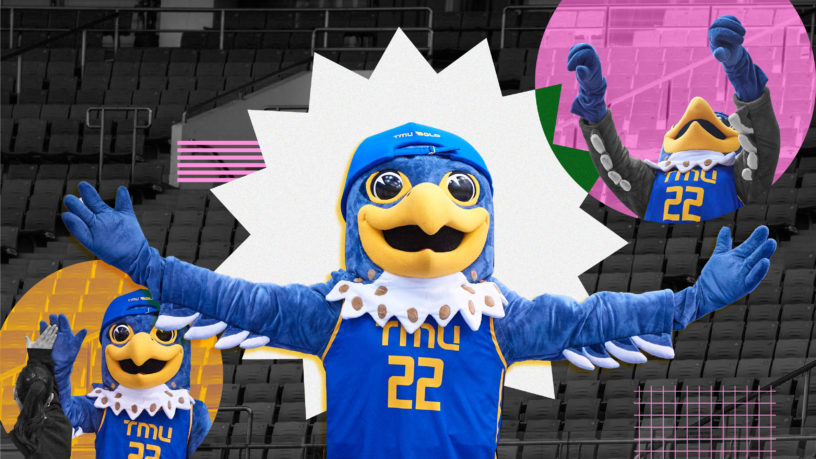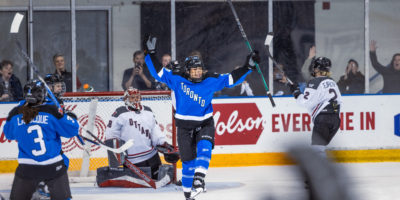By Kaden Nanji
Within the world of sporting competition, amongst the cries of the crowd and the passion of the athletes, is a presence that exudes so much energy without making a sound—the mascot.
Reflecting the public identity of an organization, these eccentric characters entertain audiences and provoke opponents with their theatrics, elevating the sporting experience for longtime and first-time fans alike.
However, mascots were not always perpetrators of chaotic silliness. According to Merriam-Webster, the origin of the word mascot dates back to the late 19th century and comes from the French term mascotte, meaning “good luck charm.”
“They used to be less comic than they are now,” Daniel T. Durbin, the director of the Institute of Sports, Media and Society at the University of Southern California, said.
In 1889, Yale University revealed the first official sports mascot, Handsome Dan, a living bulldog. Before baseball and football games, the bulldog would walk across the field, supposedly providing good luck to the teams.
Now, more than 130 years and 19 iterations later, Handsome Dan still serves as Yale’s mascot.
In 1974, the San Diego Chicken took to the stands of a San Diego Padres game, entertaining fans and joking around with the players and umpires.
“Frankie is a great example of how to bring up the culture and bring out the students to the games”
“Baseball’s a long, slow game. The Padres were not very good,” Durbin said. “They needed something to perk things up…Then you saw more and more costumes become more and more outrageous.”
Following the success of the San Diego Chicken, an increasing number of mascots were commissioned by professional sports organizations to increase viewership and keep audiences entertained during breaks in play.
“They were not just there to celebrate the team but being part of the external event promotion,” Durbin said. “They are big, noisy, promotional things to keep fans perked up during those slow moments and entertain them.”
Today, most teams—from the college level to professional leagues—have a mascot. Some of these mascots have been around for over 60 years, like the New York Mets’, Mr. Met, while others have become modern favourites, like the Philadelphia Flyers’ Gritty.
In September 2023, Toronto Metropolitan University (TMU) introduced its new mascot: Frankie the Falcon.
TMU didn’t have a mascot for over two years after they accepted the Standing Strong (Mash Koh Wee Kah Pooh Win) Task Force initiatives, which included reconsidering their former mascot Eggy the Ram.
“I love interacting with the students and the staff and everyone that’s at the game,” a person who plays Frankie said in an interview with The Eyeopener.
Frankie discussed their initial apprehension towards applying to the mascot program. However, after getting the job, they instantly recognized how fun it was to entertain the crowd from behind a nearly eight-foot-tall costume.
As Frankie became more comfortable with the audience, their antics became increasingly silly and personalized, even garnering the name “sassy Frankie” from students.
“Then you saw more and more costumes become more and more outrageous”
Frankie recalled the first time they messed with a player in the penalty box during a visit from the Carleton Ravens in November 2023. In what they said was one of the most memorable moments of being a mascot, Frankie was asked to leave early out of fear for their safety.
“I made the mistake of putting my hands into the box…and then some of the players got mad and I had to leave early,” Frankie said.
The person who plays Frankie arrives early to games and uses the elevator to protect their identity before getting dressed in a multi-layered costume. An ice vest helps them stay cool as they parade around the court.
During a game, Frankie will pose for pictures with fans, participate in intermission games and stare down the opponents as they walk into the gym.
“Mascots really help make sports more approachable to people who don’t know anything about it,” Adriana Hill, the project coordinator for TMU’s mascot program, said. “It’s a way to make it more friendly and accommodating for everyone.
Frankie thinks mascots play a key role in fostering an inclusive culture for sports fans and those new to sports by encouraging participation.
“At any sporting event, there are things that elevate the experience,” Frankie said. “And I think Frankie is a great example of how to bring up the culture and bring out the students to the games.”











Leave a Reply